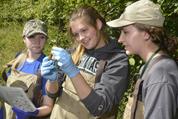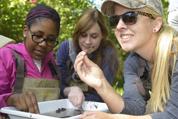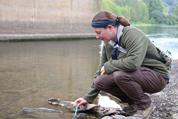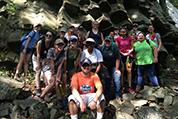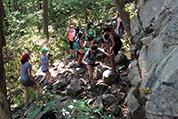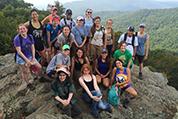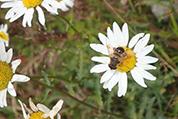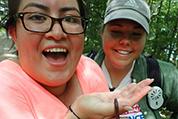A Living Classroom
What better way is there for students to learn about the environment than being immersed in it? That’s how students at the Smithsonian-Mason School of Conservation (SMSC) are learning about animals and their ecosystems. The school welcomes students and professionals from all over the world to live in a conservation facility—the Smithsonian Conservation Biology Institute—and to be inspired, empowered, and equipped with knowledge to help save species from extinction.
Participants in this program have the chance to work with some of the most rare and endangered species on the planet. They become part of the backbone of groundbreaking research and practice that serves to preserve the diversity of wildlife that surrounds them. Check out what students have been studying this year in the series of photo essays below!
EVALUATING LAND USE IMPACT ON THE WATERSHED
Students in the “Conservation, Biodiversity and Society” program took a field trip out to the Shenandoah River to learn how scientists evaluate water quality. Then, they met with landowners who have a big influence over the health and well-being of the watershed to learn about how land use can affect an ecosystem. Students sorted through a dip net made of heavy canvas to search for samples of invertebrates, like insects and arthropods. They performed tests that determine the nitrate, phosphate, dissolved oxygen, pH and alkalinity content in the watershed. After a short trip to White House Farm, students took samples from the Shenandoah River to test water temperature.
A SENSE OF PLACE IN THE BLUE RIDGE MOUNTAINS
Students began their first semester at the Smithsonian-Mason School of Conservation exploring Shenandoah National Park. Here, “Conservation, Biodiversity and Society” participants learned about local geography, ecology and geology by experiencing it firsthand. At Compton’s Peak, students examined a fascinating columnar basalt formation for their geology lesson, one of many ancient rock formations along the hiking trail. The Wildlife Ecology and Conservation students then paused to appreciate the beautiful view at the top of the Peak!
SMITHSONIAN SCHOLARS IN SHENANDOAH
Students from the University of California, Santa Barbara visited the Smithsonian-Mason School of Conservation! Part one of their ventures on the East Coast led them to Shenandoah National Park, where they met Big Meadows park rangers and learned about park management planning and priorities. Students discovered some fascinating fauna on the journey to Dark Hollow Falls, including a species of hover fly that is a honeybee mimic!
SMITHSONIAN SCHOLARS AT THE SMITHSONIAN-MASON SCHOOL OF CONSERVATION
In part two of their visit to the Smithsonian-Mason School of Conservation, students from the University of California, Santa Barbara got their hands dirty collecting field samples from Leach Pond. The students were tasked with determining the presence of amphibians (and potential diseases that might affect those species). After wading in with a dip net, the students were able to catch a few amphibians, mostly frogs and tadpoles. They found that the adult frogs were much easier to identify than their tadpoles! Back in the lab/classroom, they learned how to prep DNA samples for analysis. Afterwards, they walked through the Smithsonian ForestGEO site to meet a Smithsonian botanist who demonstrated how scientists use dendrometer bands to monitor tree growth and water cycling.
Ecology and Conservation of Migratory Birds
For the second time, the Smithsonian-Mason School of Conservation hosted a professional training course in September 2015 on the ecology and conservation of migratory birds. Eighteen professionals and graduate students from 12 different nations learned a wide range of field skills, including bird capture, banding and radiotelemetry, as well as critical analytical skills and theory. This course is taught by instructors from the Smithsonian Migratory Bird Center and other partner institutions.
David Borre of Mexico measures tail length in this captured Gray Catbird. Japheth Roberts of Ghana closely inspects feather molt patterns in this bird to estimate its age. Flora Mok of Hong Kong gets help from another participant in handling, banding, and inspecting the wing of this Yellow-breasted Chat. And, Dr. Luke Powell explains the approach to attaching a backpack VHF transmitter using the Rappole Harness technique.
This story appears in the October 2015 issue of Smithsonian Conservation Biology Institute News Learn more about the Smithsonian-Mason School of Conservation.
Do you want more great science stories in your inbox? Sign up for the e-newsletter here.
